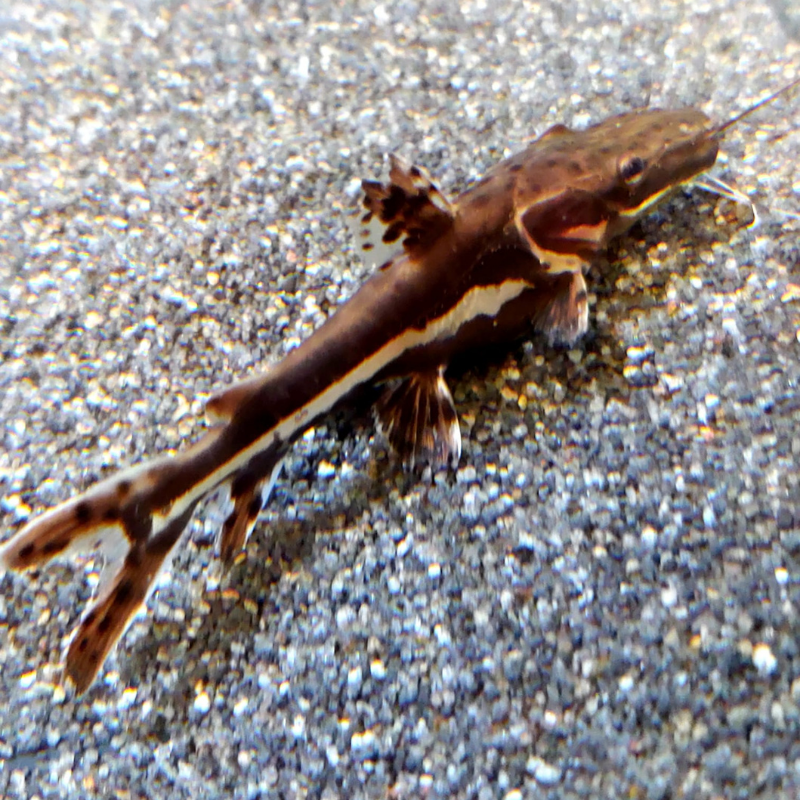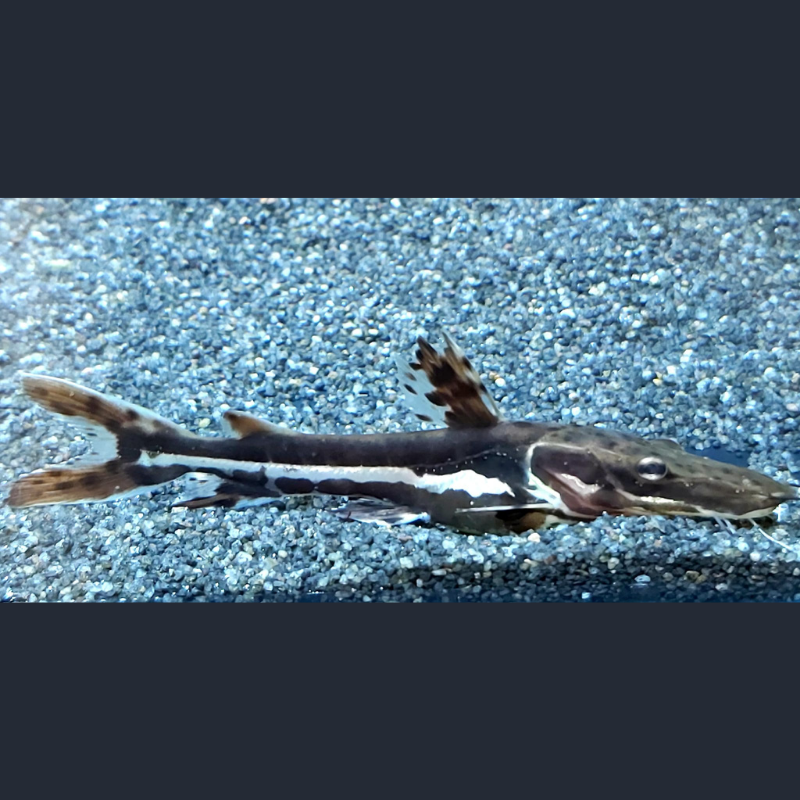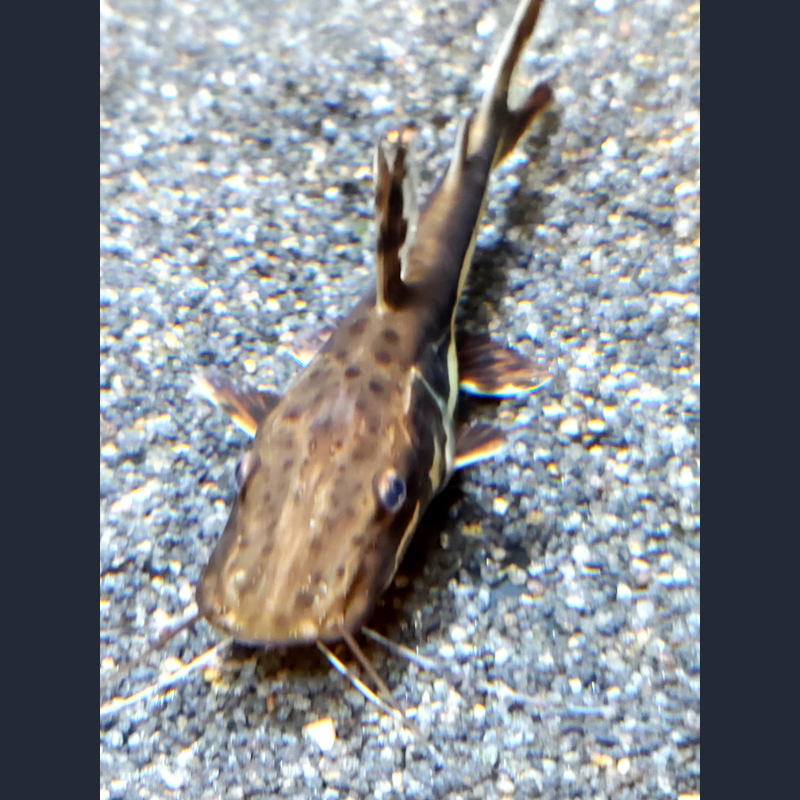Next working day delivery with Royal Mail Tracked 24
Description
Shovelnose Catfish
The Shovelnose catfish (Pseudoplatystoma sp.) originates from South America, and are so-named for its long, flat and wide snout, giving the appearance of a shovel. Shovelnose catfish can grow very large, up to three feet in length, so need a suitably large habitat to thrive. They grow very rapidly, so please ensure you do your research and have a suitable habitat prior to purchasing - they will outgrow smaller unsuitable aquaria very quickly. Fully grown shovelnose catfish will require an aquarium of 700 litres plus ideally, to avoid cramped and stressful conditions.
Shovelnose catfish are often found in dense vegetation in the wild, so a shady, heavily planted aquarium with driftwood and rocks is recommended. The shovelnose uses its barbel's to both navigate in dark murky waters and hunt for prey. Shovelnose catfish are considered predatory and are often spotted skimming the floor with its wide flat snout hunting for food. Shovelnose catfish will feed on smaller fish or anything else unfortunate enough to fit in its mouth. They are very active swimmers, so should not be considered a 'bottom-feeder'.
This listing is for a juvenile Shovelnose catfish (typically the species Pseudoplastoma fasciatum - although not guaranteed). While small, juvenile shovelnose catfish are quite different in colour and patterning from adults. In the juvenile, the fish is dark on its back with an obvious boundary between the white of its sides and belly. The juvenile fish lacks stripes of P. fasciatum and P. tigrinum, but has spots instead. The adult colour is brown-olive, with up to a dozen or more dark transverse bands reaching up to the belly, which is typically white with a few dark spots. As it grows and matures into an adult, its physical characteristics will change, and the patterning and colouration should develop into a particular classification of species.
Are Shovelnose Catfish difficult to keep?
Shovelnose catfish are very hardy, and are not difficult to keep alive and healthy. But they will grow rather large, rather quickly - so you need a big aquarium - and have predatory tendencies, so its recommended that beginners avoid Shovelnose catfish until they’ve had a bit more experience. You will need a very large aquarium for long-term care, and must pay close attention to the needs and compatible tankmates of the shovelnose catfish. It is essential to do some thorough research before deciding to keep one.
Are Shovelnose Catfish aggressive?
Shovelnose Catfish are not overly aggressive towards other fish, but they will eat smaller fish or shrimp and anything considered vulnerable prey. Shovelnose catfish should be considered predatory, with a semi-aggressive to aggressive temperament.
What can I keep with Shovelnose Catfish?
You will need to house them with tankmates of a similar size and growth rate, that are not aggressive or territorial. You will typically find shovelnose catfish housed with similar species, such as Redtail catfish, or more commonly with giant Gourami, Oscars and Pacu. Obviously this requires caution, and a suitably large habitat to accommodate.
How big do Shovelnose Catfish grow?
Shovelnose catfish in the wild may grow to around 4 feet, but in captive aquaria commonly reach 2.5 to 3 feet in length. They have a very fast growth rate too, and will quickly reach maturity. A diet high in protein will help facilitate rapid and healthy growth.
Features
Approx. supplied size: 3-6" / 7-12cm
Maximum size: 36" / 90cm (3 feet)
Origin: South America
Family: Pimelodidae
Temperament: Predatory, semi-aggressive
Lighting requirement: low
Ideal number kept together: 1+
Water conditions
Our conditions: pH 7.5, temp 25 °C
Ideal pH: 6.0–8.0
Hardness: 6-20 KH
Water flow: low
Ideal Temperature: 23–28 °C
Ease of care
Advanced. Hardy and long-lived, shovelnose catfish are definitely not for the beginner, and often require significant investment in habitat for long-term care. It is not difficult to feed them, and they will grow extremely quickly, but you must ensure you get the habitat right. They will eat a lot of food when full grown, so be prepared to meet its dietary needs.
Feeding
Shovelnose catfish grow large and require a high-protein diet. While juvenile, feed a mixture of algae wafer and catfish pellet with vegetable matter and the occasional meaty supplement, such as bloodworm or small shrimp. As they grow, increase the meat in their diet with fresh or frozen protein-rich food. Be aware that they will attempt to eat small fish and crustaceans, given the opportunity.
Breeding
Shovelnose catfish are not commonly bred in captive aquaria, it is very difficult to mimic conditions in the wild. Unless you are fortunate enough to have many large aquariums to separate and segregate males and females, any attempt to breed will prove problematic and is not generally recommended.
Life Span
Shovelnose catfish can have a lifespan of over 20 years in perfect conditions, but they are unlikely to live so long in captivity. It is not uncommon for shovelnose catfish to live over 10 years in aquaria. Photo is for illustration only - one supplied.
For more information on general fishkeeping and our shipping procedures click here.
Shipping Cut Off Times
- In stock orders placed before on working weekdays before 2pm will be despatched on the same working weekday.
- In stock orders placed on a Saturday before 10am will be despatched on that Saturday.
- Orders that include pre-order items will be shipped together in total once the pre-order items arrive back in stock using the delivery service chosen at checkout.
None of these cut-offs apply to palletised items, pond plants or fibreglass ponds.
| SERVICE | SPEND | COST |
| Packet/Courier items | ||
| Royal Mail Next Day (1-2 days) | £0.00-£49.99 | £3.99 |
| DPD Local Next Day (1 day) | £0.00-£49.99 | £6.99 |
| DPD Local Saturday | £0.00-£49.99 | £14.99 |
| DPD Local Sunday | £0.00-£49.99 | £14.99 |
| DPD Local Next Day (1 day)*** | £50 and up | FREE |
| DPD Local Saturday | £50 and up | £9.99 |
| DPD Local Sunday | £50 and up | £9.99 |
| Pallets (booked in) | aquariums / bulky items | |
| Pallets Standard (3-5 days) | - | FREE |
| Pallets Express (1-2 days) | - | £39.99 |
| *EXCLUDED ITEMS | extra delivery fees apply | |
| Fibreglass Ponds (booked in) | ||
| Zone 1 (7-10 days) | - | £79.99 |
| Zone 2 (7-14 days) | - | £149.99 |
| Zone 3 (7-21 days) | - | £249.99 |
| Pond Plants (direct from grower) |
||
| All pond plants (3-10 days) | one-off fee regardless of order size/value | £5.99 |
***Orders with a value between £50 and £80 that are under 2kg in weight may be sent via a Royal Mail Next Day Signed for service.
Further delivery information
All delivery services are working day services and do not include delivery on Saturdays and Sundays or public holidays as standard.
Deliveries are usually Monday to Friday only, although some Royal Mail items may be delivered on weekends as standard if the service is available in your area.
Orders over £50 delivering to non UK mainland locations may be despatched via a Royal Mail (2-3 days) service rather than an express shipping option.
Please see our full delivery information page and terms and conditions for detailed information on shipping policies and zones



